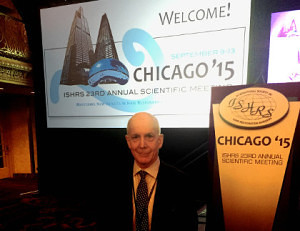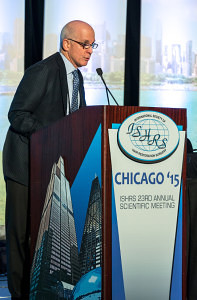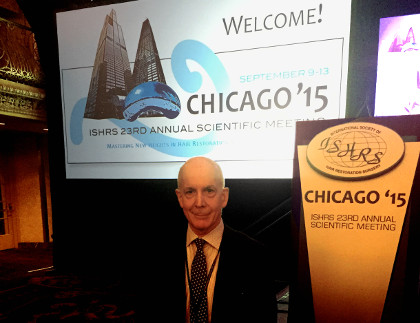 Dr. Bernstein at the 2015 ISHRS Annual Scientific Meeting
Dr. Bernstein at the 2015 ISHRS Annual Scientific MeetingSmall, simple modifications in the sequence of the major steps in a Follicular Unit Extraction (FUE) hair transplant procedure will be beneficial to healing and growth following the procedure, says renowned hair restoration surgeon Dr. Robert M. Bernstein. Presenting at the 23rd Annual Scientific Meeting of the International Society of Hair Restoration Surgery (ISHRS) in Chicago, Illinois, Dr. Bernstein detailed how making recipient site incisions before harvesting follicular unit grafts can improve the outcome of an FUE procedure.
For years, it was standard operating procedure in an FUE hair transplant to first harvest follicular units, then create recipient sites in the balding areas and place the extracted units into these sites. This practice persisted despite the fact that hair restoration physicians had known for years that prolonged periods of time outside the body decreased survival of follicular unit grafts. With the widespread adoption of FUE, and the long time needed for the extraction phase of the procedure, Dr. Bernstein looked for ways to streamline the process.
By making the requisite number of recipient sites before harvesting, the grafts can be placed as soon as they are extracted. This reduces the critical period of time that grafts are out of the body. Sites created before harvesting have more time to begin healing, and so they exhibit less bleeding. This results in fewer grafts that “pop” out of the recipient site during placement. Mechanical trauma to grafts that need re-positioning after popping is also reduced. Allowing time for recipient sites to begin healing might also provide a more fertile bed for newly implanted grafts to take root. Additionally, pre-making sites provides time for crusts to form on the surface of the wound. Removing these crusts before placement decreases post-operative inflammation and promotes wound healing.
Dr. Bernstein proposed that in some large FUE sessions, in which large numbers of follicular units are transplanted, the surgeon might deliberately delay extraction to allow pre-made recipient sites additional time to heal by creating recipient sites the day before harvesting.
In sum, Dr. Bernstein provided the audience of hair restoration surgeons with a practical modification of the traditional FUE procedure that could impact the outcome of every hair transplant. Given the growth in the number of FUE hair transplants being performed (now about 50% of all hair transplant procedures) and the international platform provided by the ISHRS Annual Scientific Meeting, this small procedural adjustment could have a significant benefit for thousands of hair restoration patients around the world.
Read these publications by Dr. Bernstein on recipient site creation:
Pre-Making Recipient Sites to Increase Graft Survival in Manual and Robotic FUE Procedures (2012)
Robotic Recipient Site Creation in Hair Transplantation (2014)







